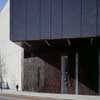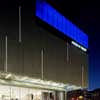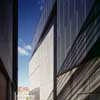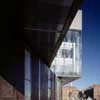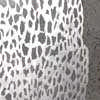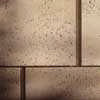House of Fraser Bristol, Cabot Circus, Shop, Building, Architect, Picture, Project
House of Fraser, Bristol : Cabot Circus Store
Retail Development Bristol, England, UK – design by Stanton Williams
House of Fraser Bristol
Cabot Circus, Bristol
2008
Design: Stanton Williams
House of Fraser at Cabot Circus
Stanton Williams’ store for House of Fraser in Bristol anchors the new Cabot Circus development, which is intended to breathe fresh life into this hitherto run-down part of the city centre. The building was conceived as a dramatic landmark, visible for some distance and marking the entrance to the central area. At the same time, it is intended to create interest at the scale of the passing pedestrian or motorist by virtue of its sculptural form and the tactile nature of its surfaces, developed in close collaboration with the artist Susanna Heron. It challenges the banality of much retail architecture and the current preference for iconic ‘black-box’ stores, unrelated to their surroundings and perhaps transient in their fashionability. Instead, it seeks to connect with the urban landscape of Bristol, reinterpreting the traditional nineteenth-century department store by means of a creatively-deployed palette of materials and careful detailing.
Cabot Circus is a new development which extends and draws together the three parallel streets of the 1950s Broadmead shopping area as a series of semi-covered spaces onto which face ‘buildings’ by various architects. At the focal point where the three converging arcades meet, the masterplan envisaged an ‘anchor’ store, for which we were appointed. Conventional retail architecture wisdom would view the elevation which faces into the shopping area as the principal faÁade, and the rest – facing the surrounding streets – as the ‘rear’. However, our design treats the entire envelope as a principal elevation, intended to enliven the locality and to fulfil the brief that this building would signal the gateway to the city.
The north and eastern boundaries of the site are formed by the curving line of Bond Street, with a major junction at the north-eastern corner. Rather than present a continuous faÁade literally emulating the street line, at pavement level the building comprises a series of short, straight sections (drawn as chords across the curve). This jagged edge provides pedestrians and motorists with views which shift and alter depending on the angle of approach whilst also creating interest by revealing the streetscape in unfolding stages. The upper storeys consist of massive cubic volumes, arranged independently of the pavement-level plinth and in fact dramatically overhanging it at points. Their dynamic, sculptural form recalls shifting tectonic blocks sliding past each other, thrust out of the ground and thus closely related to their setting. This geological allusion is reinforced by the strata-like ‘gap’ between the lower and upper parts of the elevation and by the treatment of the facades themselves.
Above plinth level, the elevations are principally clad in stone-faced precast concrete panels, arranged in portrait format. The largest is some two metres by nearly ten, weighing a maximum of 10.91t. The geological theme is developed in the use of Roach bed Portland stone as the principal facing material. Hard and durable, Roach is noteworthy for its high fossil content: where the shells have long since decomposed within the stone there are now holes – negatives, or moulds, in effect – which imbue it with a lively, textured appearance. At the principal corner of the building, smoother Whitbed stone from the same quarry is used, contrasting with the Roach in the way that it is caught by the light, and in its appearance when wet. The impression is akin to a textured garment worn smooth at a certain point by frequent contact.
The stone volumes are broken up at intervals by ‘faults’, namely slots that are either glazed or artificially lit and which create the impression of further movement. At the corners of the volumes, large glass panels are deployed flush with the stonework. They appear not as simple lightweight openings, but rather as solid, reflective blocks by day and beacons of light at night. This is especially true of the translucent section that is located at the highest corner and which is visible for some distance. The panels’ contrast with the surrounding stonework further accentuates the sense of tectonic plates sliding across each other. More tangibly, they allow views from the building by day and views in at night, orientating shoppers and avoiding the dislocation of the typical ‘black-box’, while the vast double-height display window at the Bond Street junction is critical in giving the building an ‘active’ frontage at plinth level.
The organic, tactile theme introduced by the Roach bed stone is continued in the palette of materials used elsewhere on the building. The plinth level features panels of bronze, weighing up to 160kg. These panels were deliberately cast to produce a rich texture with as much variation and relief as possible – each one is unique. The effect could be conceived in terms of molten metal, perhaps forced out of the earth by tectonic shifts, but the result, like the Roach, is a surface which catches the light in varied ways and which people will want to touch – another kind of ‘active’ frontage, in effect. The panels are juxtaposed with smooth copper cassettes, which, like the bronze, will acquire a deep patina over time.
Susanna Heron worked closely with us on the bronze panels. She sought to develop the ideas of negative relief and life suggested by the fossil-rich stonework, and so twenty-seven panels are partly milled smooth according to her directions. The sinuous edge of the junction between the milled and the untreated, textured areas again recalls the idea of molten metal. In places, the cast surface was below the level of the milling, creating a negative texture akin to the fossilised stone. Susanna was also involved in the treatment of the largest glazed section in the upper volume, a vast surface six metres tall by fourteen wide that is uninterrupted by internal floors. Each of its panes was individually sand-blasted and acid-etched by hand to a unique organic pattern of her design. The technique, which had never before been used on this scale in the UK before, creates an incredible dappled effect. By day, natural light shining through will cast shadows and forms internally; by night, the window will project patterns onto the external walls. As with the bronze panels, this window represents a very real, natural collaboration between artist and architect which elaborates and extends the guiding themes of the design; this is not the application of art to an already completed architectural vision.
In some ways, the attention given to materials and detailing in this project recalls a bespoke couture garment. But the considered combination of natural stone, glass, bronze and public art also allows the building to be understood as the contemporary reinterpretation of the grand department stores of the late nineteenth century. In this way, in the building’s organic response to its setting, and in its interaction with its users, our design aims to be at once contemporary and timeless.
House of Fraser Bristol photos + information from Stanton Williams Architects 111208
House of Fraser Cabot Circus : Stanton Williams Architects
Location:England
English Architecture
English Architecture Design – chronological list
Bristol Buildings – Selection
Arnolfini Icon
51N4E
![]()
picture from architect
Bristol Icon
Bristol Metropolitan College
Wilkinson Eyre Architects
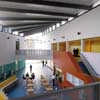
photo from CABE
Bristol Metropolitan College
Comments / photos for the House of Fraser Bristol – Cabot Circus Store Architecture page welcome
House of Fraser Bristol Building – page
House of Fraser Cabot Circus – external link

